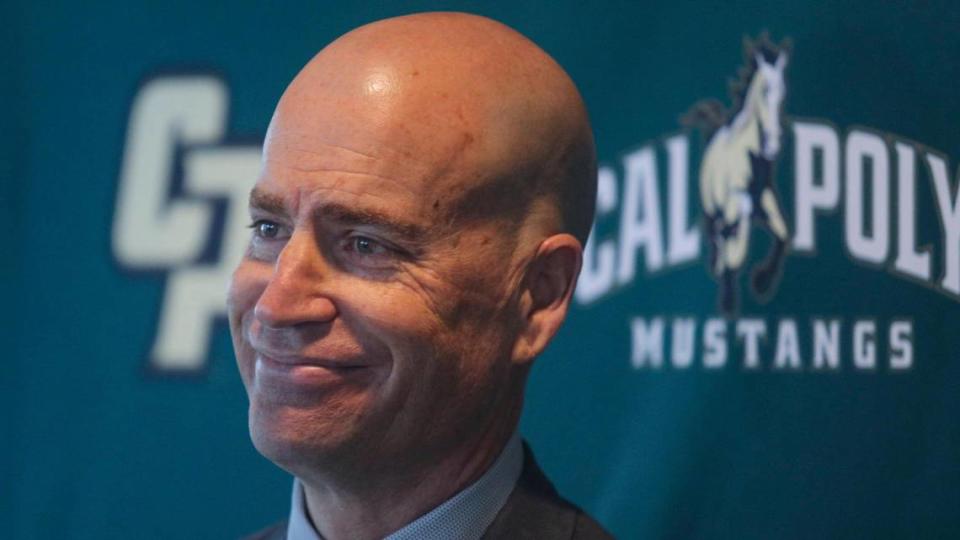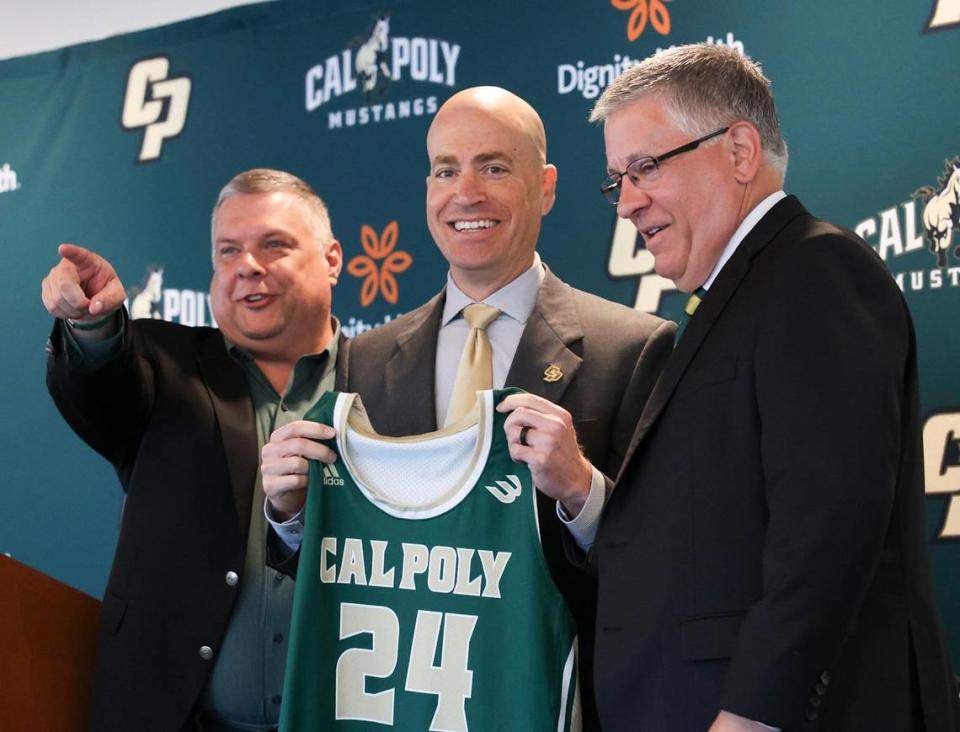Cal Poly introduces Mike DeGeorge as its new basketball coach: He wants to ‘let it fly’
Cal Poly basketball is hoping for a reset coming off a season where the Mustangs finished 4-28 and 0-20 in Big West play, and they’re looking to Mike DeGeorge to lead the change.
After a rocky five seasons, the school announced on March 1 that it would part ways with former Head Coach John Smith.
Less than a month later, Cal Poly announced the hiring of DeGeorge from Division II Colorado Mesa, and on Thursday, the university welcomed him in a news conference at the Performing Arts Center.
At DeGeorge’s past stops at the Division II and Division III levels, he was known as a program builder. Before he arrived at Division II Colorado Mesa, the Mavericks had won only 19 games.
Six seasons later, DeGeorge led Colorado Mesa to the Sweet 16 of the Division II NCAA Tournament and accumulated three Rocky Mountain Athletic Conference regular-season titles and two conference championships. The Mavericks also earned their first-ever No. 1 national ranking under DeGeorge.
At Division III Rhodes College, DeGeorge turned a program around after 10 straight losing seasons. He led the program to its first conference championships in 20 years and its first appearance in the NCAA Division III National Tournament for the first in 24 years.
“Coach DeGeorge has a proven track record of 24 years as a head coach building programs and turning them into consistent winners,” Cal Poly director of athletics Don Oberhelman said at the news conference.

Coach’s style of play
DeGeorge brings a modern approach to play. At Colorado Mesa, the Mavericks were third in three-point shots made per game with 11.4 and first in two-point field goal percentage.
If the numbers from Colorado Mesa were compared to those of other schools in the Big West from this past season, the Mavericks would’ve been first in three-point attempts by nearly 170 attempts, tied for first in three-point percentage (36%), and by far first in three-point makes per game (11.4).
DeGeorge’s style of play mimics a growing trend at the NBA level: teams focusing their attack from the three-point line and shots close to the basket and limiting the number of midrange shots.
“If you look at the highest level of basketball, more and more teams are playing this because it’s analytically the best way to play. You got to draw the defense out, so that you have an opportunity to make plays,” DeGeorge said.
During his time at Rhodes College in Memphis, DeGeorge developed a relationship with the Memphis Grizzlies organization, which began using analytics to inform its decisions. He credits his time at Rhodes College with helping him think outside of traditional basketball norms.
However, DeGeorge emphasized that his teams don’t shoot three-pointers for the sake of it.
“We’re committed to getting the ball to the paint,” DeGeorge said. “Whoever wins the paint wins basketball.” He compared winning the inside game to “winning the trenches in football.”
When a player drives the ball to the paint, DeGeorge wants his players to force the defense to rotate. When the defense reacts, that’s when DeGeorge wants his players to spray the ball out for three-point looks.
In a video released by Cal Poly Athletics, Oberhelman said he was impressed by DeGeorge’s style of play and believed it could help “equalize” early in DeGeorge’s tenure when the Mustangs might not be as talented or experienced as other teams.
Playing through mistakes
One thing DeGeorge highlighted to the audience and media was that he wants players to “let it fly.”
“You got to be OK with missing,” DeGeorge said. “You get high-achieving guys. You get guys that are playing Division I athletics and are good enough students to get into a place like (Cal Poly). They’re high-achievers and they don’t want to make mistakes.”
DeGeorge wants his players to recognize the fact that the game won’t be perfect.
“We’re going to miss probably 65% of our shots,” DeGeorge said. “That is a psychological hurdle people have to get past. We have to free them up so they’re comfortable letting it fly.”
Under John Smith, the Mustangs struggled on the offensive end. In the 2023-24 season, the Mustangs ranked 344th out of 351 Division I mens basketball programs in points scored per game at 63.7.
With DeGeorge at the helm, the Mustangs will look to improve that number.

Why did Cal Poly pick DeGeorge?
According to Oberhelman, the decision-makers interviewed nearly 50 candidates for the position. Coaches ranged from all levels of college basketball, including current Division I assistants.
“When you’re hiring a Division I assistant, there’s a little bit of a question mark,” Oberhelman said. “Can you run a program? Do you actually know how to do this.”
DeGeorge, on the other hand, has been a head coach for 24 years.
In Cal Poly’s history as a Division I program, the Mustangs have never won more than 20 games in a season and have won the Big West Tournament only once, in 2014. There are questions if a successful mens basketball program can be built at Cal Poly.
Oberhelman pointed out that many other sports at Cal Poly are having success.
“I think we’re demonstrating that success right now across the board,” Oberhelman said. “Mens basketball can match that success. It make take us a year or two. I know our fans don’t want to hear that, but this is going to be a process.”
DeGeorge has a reputation as a program builder. Although he hasn’t had the opportunity to do at the Division I level, he’s succeeded at his past stops.
“I love the building process,” DeGeorge said. “I’m not going to back down from challenges. I”m excited to build a program, and now it’s trying to create a really positive environment.”
One area of concern for the program is recruiting and the transfer portal. According to 247 Sports, since the transfer portal opened up on March 18, more than 1,000 players have entered looking for a new school.
Many of Cal Poly’s players from last season have joined that group. Senior guard Kobe Sanders, who led the team in scoring with 19 points per game, committed to the University of Nevada for his final year of eligibility.
Promising freshmen Justin Page and Quentin Jones were recruited by Smith but have also entered their names in the portal.
It’s a trend that carries over to last year, when the team lost several promising players including Brantly Stevenson and Alimamy Koroma.
“It’s a changing landscape, and everybody’s like, ‘Well, what do we do about this,” DeGeorge said. “One of the things that’s happened for me, because I’ve been in places that weren’t strong, is that we had to build them up.”
When Oberhelman was asked about how Cal Poly is approaching recruiting in the age of the transfer portal and athletes being able to profit off their name, image and likeness, he said that “it’s selling relationships and building true connections with your student.”
“Does that mean we’re not going to lose somebody who is going to get $200,000 to go somewhere else? I think we likely will. But I think we can mitigate that by selling the education that we have here and your future income.
“As long as we focus on selling the developmental aspect of what we can do at Cal Poly versus chasing the dollar, I think we’re OK.”

